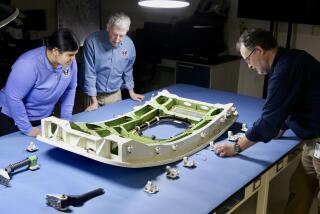Minisub May Join Search for Door Torn Off Jetliner
- Share via
SEATTLE — Federal investigators may use a miniature Navy submarine, or a deep sea recovery ship like the one the CIA used to haul up parts of a sunken Russian submarine, to retrieve the cargo door that tore off a jumbo jetliner near Hawaii in February, hurling nine passengers to their deaths.
Lee V. Dickinson, a National Transportation Safety Board member who is heading up the investigation into the accident aboard United Airlines flight 811, said Tuesday that recovery of the door from 15,000 feet below the surface of the Pacific is not essential to the probe. But “there’s no question that we can completely close the loop if we can get the door,” he said.
“We know where it hit the water,” Dickinson told reporters during a break in the first day of week-long hearings on the accident. Radar tracked the door from the time it ripped off the 747 about 40 minutes after takeoff and down 22,000 feet to its impact point about 80 miles southeast of Honolulu.
‘Haven’t Decided’
“We think we can find it,” he said. “We just haven’t decided whether to do it.”
Three factors mitigate against an undersea search, the NTSB board member said.
The first is that his investigators believe they eventually will be able to do a pretty good job of figuring out what happened without the door--relying heavily, instead, on the testimony of experts, and on evidence gleaned from the frame from which the door tore.
The second is that use of a Navy minisub would probably have to wait until October, when one will become available. By then, seas will be getting rough, complicating any recovery efforts.
The third is that the use of a privately owned recovery ship, although available now, would be expensive--”probably several million dollars,” Dickinson said.
If the NTSB does decide to use such a ship, it will probably be the Glomar Explorer, or one of its ilk, Dickinson said.
The Howard Hughes-built Glomar Explorer was used by the Central Intelligence Agency in 1974 to recover and study parts of a Soviet nuclear sub that had sunk off the coast of Hawaii with the loss of all on board.
Offsetting the cost and other problems of such undersea recovery efforts is the fact that--thus far at least--investigators are having a hard time figuring out exactly what went wrong with the door.
As the United Boeing 747 climbed out of Honolulu on a scheduled flight to Aukland, New Zealand, with 357 on board, the 10-by-10-foot door ripped off, carrying with it a 10-by-10-foot slab of the outer passenger cabin wall directly above.
The difficulty of answering why was illustrated Tuesday in testimony at the hearing by Robert Dann, an engineer with Pan American World Airways.
Pan Am had experienced an apparently similar incident in March, 1987, when a cargo door partially opened on a 747 flight from London, bound for San Francisco. The investigators are hoping that non-fatal incident--which prompted a Federal Aviation Administration directive, calling for strengthening of all 747 cargo doors--will provide important clues as to what happened on Flight 811.
Not Related
However, in his often highly technical testimony on Tuesday, Dann seemed to indicate that the two incidents were not directly related.
“I believe the . . . Pan Am incident was very isolated, and was related to the mechanical closing of the door,” Dann said, suggesting that some uncorrected adjustments by a ground crewman using a wrench may have caused the Pan Am door to spring open over the Atlantic, forcing the flight to return to London.
In contrast, the United cargo door was closed electrically, and there has been no indication, thus far, at least, that the ground crew followed any incorrect procedures in closing the door.
To suggestions Tuesday that the cargo door, itself, may be of faulty design, James T. Fitzgerald, a Boeing engineer, responded firmly that “it’s been a safe and reliable system for many, many years.”
Dann said he wasn’t so sure, noting that tests made by Pan Am after their accident showed that the latches on the cargo door could be disengaged with a wrench, despite a locking system designed to keep them securely closed.
The possibility that these latches on Flight 811 somehow opened after locking, and the pressurization inside the plane caused the door to burst open when the Boeing 747 reached the relatively thin air at 22,000 feet, is one theory under consideration.
However, the ground crew said it did not attempt to adjust the latches after locking, and there is no explanation how the latches might have disengaged on their own.
More to Read
Sign up for Essential California
The most important California stories and recommendations in your inbox every morning.
You may occasionally receive promotional content from the Los Angeles Times.













